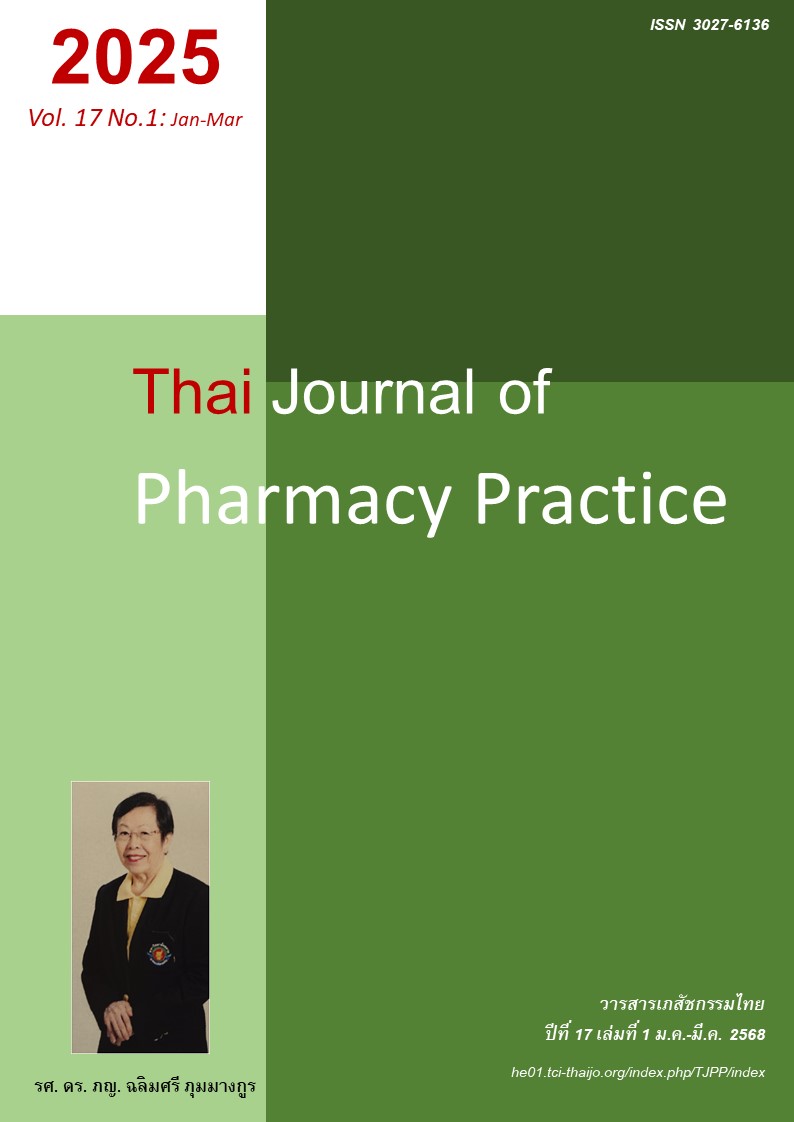ความชุกและปัจจัยที่สัมพันธ์กับการควบคุมระดับความดันโลหิตไม่ได้ในผู้ป่วยโรคความดันโลหิตสูง
Main Article Content
บทคัดย่อ
วัตถุประสงค์: เพื่อหาความชุกและปัจจัยที่สัมพันธ์กับการควบคุมระดับความดันโลหิตไม่ได้ในผู้ป่วยโรคความดันโลหิตสูง วิธีการ: การศึกษารวบรวมข้อมูลผู้ป่วยโรคความดันโลหิตที่มารับบริการที่คลินิกรับยาต่อเนื่องและคลินิกทั่วไปที่มีรหัสวินิจฉัยโรค I10-I15 จากฐานข้อมูลอิเล็กทรอนิกส์ของโรงพยาบาลทั่วไปขนาด 500 เตียงแห่งหนึ่งตั้งแต่ 1 กุมภาพันธ์ พ.ศ.2561 ถึง 31 มกราคม พ.ศ.2563 ปัจจัยที่ศึกษาเพื่อหาความสัมพันธ์กับการควบคุมระดับความดันโลหิตไม่ได้ได้แก่ ปัจจัยทางสังคมและประชากรศาสตร์ และปัจจัยทางสุขภาพและยา ผลการวิจัย: ผู้ป่วยทั้งสิ้น 7,849 คนในการศึกษาเป็นผู้ป่วยในคลินิกรับยาต่อเนื่อง 94 คน และผู้ป่วยในคลินิกทั่วไป 7,755 คน ความชุกของการควบคุมระดับความดันโลหิตไม่ได้คิดเป็นร้อยละ 79.4 ผู้ป่วยในคลินิกรับยาต่อเนื่องร้อยละ 73.4 และผู้ป่วยในคลินิกทั่วไปร้อยละ 79.5 ควบคุมระดับความดันโลหิตไม่ได้ เมื่อพิจารณาจากข้อมูลความดันโลหิตที่วัดระหว่างวันที่ 1 กุมภาพันธ์ พ.ศ.2561 ถึง 31 มกราคม พ.ศ.2563 พบว่า มีเพียง 4 ปัจจัยที่มีความสัมพันธ์กับการควบคุมระดับความดันโลหิตไม่ได้อย่างมีนัยสำคัญทางสถิติ โดยเพศชาย ดัชนีมวลกายที่มาก และจำนวนรายการยาลดความดันโลหิตที่ผู้ป่วยได้รับซึ่งมากขึ้น เพิ่มความเสี่ยงของการควบคุมระดับความดันโลหิตไม่ได้ แต่การมีโรคหัวใจและหลอดเลือดร่วมด้วยลดความเสี่ยงของการควบคุมระดับความดันโลหิตไม่ได้ สรุป: ผู้ป่วยเพศชาย ผู้ที่มีดัชนีมวลกายมากกว่า 18.4 kg/m2 และผู้ที่ใช้ยาลดความดันโลหิตมากกว่า 1 รายการ ต้องได้รับการพิจารณาอย่างรอบคอบก่อนส่งผู้ป่วยเข้าสู่คลินิกรับยาต่อเนื่อง เนื่องจากผู้ป่วยกลุ่มนี้มีความเสี่ยงที่จะควบคุมระดับความดันโลหิตไม่ได้
Article Details

อนุญาตภายใต้เงื่อนไข Creative Commons Attribution-NonCommercial-NoDerivatives 4.0 International License.
ผลการวิจัยและความคิดเห็นที่ปรากฏในบทความถือเป็นความคิดเห็นและอยู่ในความรับผิดชอบของผู้นิพนธ์ มิใช่ความเห็นหรือความรับผิดชอบของกองบรรณาธิการ หรือคณะเภสัชศาสตร์ มหาวิทยาลัยสงขลานครินทร์ ทั้งนี้ไม่รวมความผิดพลาดอันเกิดจากการพิมพ์ บทความที่ได้รับการเผยแพร่โดยวารสารเภสัชกรรมไทยถือเป็นสิทธิ์ของวารสารฯ
เอกสารอ้างอิง
International Society of Hypertension. Background information on high blood pressure [online]. 2017 [cited Jun 15, 2019]. Available from: ish-world.com/ back ground-information/.
World Health Organization. A global brief on hyper- tension silent killer, global public health crisis. Switzerland: World Health Organization; 2013.
Centers for Disease Control and Prevention. National vital statistics system, mortality 2018-2021 on CDC WONDER online database [online]. 2021 [cited May 21, 2023]. Available from: wonder.cdc.gov/ucd-icd 10-expanded.html.
Division of Non-communicable Diseases. World hypertension day campaign issues 2018 [online]. 2018 [cited Apr 15, 2019]. Available from: www.thai ncd.com › info › non-communicable-disease.
Aekplakorn W, Puckcharern H, Satheannoppakao W. Thai National Health Examination Survey, NHES VI. Bangkok: Aksorn Graphic and Design; 2021.
Sirichayanukul T. Pharmacy and therapeutics com- mittee meeting minutes Phrae hospital. Phrae: Phare Hospital; 2018.
Billups SJ, Delate T, Newlon C, Schwiesow S, Jahnke R, Nadrash A. Outcomes of a pharmacist-managed medication refill program. J Am Pharm Assoc 2013; 53: 505-12. doi: 10.1331/JAPhA.2013.13008.
Sumpanprateep S. Evaluation the effectiveness of “Termya Termsuk” (Fill Pills Fill Happiness) project. Medical Journal 2016; 2: 59 – 68.
Lertsinudom S, Tawinkan N, Hansuri N, Nasatid A. Outcomes of family pharmacist network services in Universal Health Care Coverage. Thai Journal of Pharmacy Practice 2018; 10: 382-91.
Ratanakul W. Refill clinic: Emerging trend in pharmacy practice. Hospital Pharmacy Newsletter 2008; 1: 7.
Strategy and Planning Division, Office of the Perma- nent Secretary, Ministry of Public Health. Data collection and recording standards in healthcare facilities 2007. Bangkok: The War Veterans Organization of Thailand; 2016.
Strategy and Planning Division, Office of the Perma- nent Secretary, Ministry of Public Health. Data quality monitoring and control in the health service system recording information on service users and giving ICD codes. Bangkok: Printing House of Sam Charoen Panich; 2015.
Sakboonyarat B, Rangsin R, Kantiwong A, Mungthin M. Prevalence and associated factors of uncontrolled hypertension among hypertensive patients: a nation-wide survey in Thailand. BMC Res Notes 2019; 12: 380. doi: 10.1186/s13104-019-4417-7.
Roba HS, Beyene AS, Mengesha MM, Ayele BH. Prevalence of hypertension and associated factors in Dire Dawa city, Eastern Ethiopia: A community-based cross-sectional study. Int J Hypertens 2019: 9878437. doi: 10.1155/2019/9878437.
Shen Y, Chang C, Zhang J, Jiang Y, Ni B, Wang Y. Prevalence and risk factors associated with hyper- tension and prehypertension in a working population at high altitude in China: a cross-sectional study. Environ Health Prev Med 2017; 22: 19. doi: 10.1186/ s12199-017-0634-7.
Kitreerawutiwong K, Sanguanwongwijit S, Sanguan wongwijit O, Phongmanee W, Chumee P, Buapra chum A. Actors related to blood pressure control among hypertensive patients in Nongphra Sub-district health promoting hospital, Wangthong District, Phitsanulok Province. Journal of Boromara jonani College of Nursing 2017; 2: 25-35.
Asresahegn H, Tadesse F, Beyene E. Prevalence and associated factors of hypertension among adults in Ethiopia: a community based cross-sectional study. BMC Res Notes 2017; 10: 629. doi: 10.1186/s 13104-017-2966-1
Chitpulkusol P. Factors related to blood pressure controls in patients with hypertension of Thabsakae Hospital. Journal of Health Systems Research 2008; 2: 1336-43.
Ibekwe RU. Modifiable risk factors of hypertension and socio‑demographic profile in Oghara, Delta state; prevalence and correlates. Ann Med Health Sci Res 2015; 5: 71-7. doi: 10.4103/2141-9248.149 793.
Cordero A, Bertomeu-Martinez V, Mazo P, Facila L, Bertomeu-Gonzalez V, Cosin J. Factors associated with uncontrolled hypertension in patients with and without cardiovascular disease. Rev Esp Cardiol 2011; 64: 587–93. doi: 10.1016/j.recesp.2011.03. 008.
Abebe SM, Berhane Y, Worku A, Getachew A. Prevalence and associated factors of hypertension: a crossectional community based study in Northwest Ethiopia. PLoS One 2015; 10: e0125210. doi: 10.13 71/journal.pone.0125210.
Imsombati M. Factors affecting blood pressure in patients with hypertension in Thachang District, Singburi Province. Journal of Health Systems Research 2008; 2: 119-28.
Thai Hypertension Society. Guidelines in the treat- ment of hypertension 2019. Chiang Mai: Trickthink; 2019.
Baray AH, Stanikzai MH, Wafa MH, Akbari K. High prevalence of uncontrolled hypertension among Afghan hypertensive patients: a multicenter cross-sectional study. Integr Blood Press Control. 2023; 16: 23-35. doi: 10.2147/IBPC.S417205.
Aekplakorn W, Sangthong R, Kessomboon P, Putwa tana P, Inthawong R, Taneepanichskul S, et al. National Health Examination Survey IV study group. Changes in prevalence, awareness, treatment and control of hypertension in Thai population, 2004-2009: Thai National Health Examination Survey III-IV. J Hypertens. 2012; 30: 1734-42.
Hnukhum B. Impact of a pharmacist-managed medi- cations refill clinic on quality of hypertensive care [master thesis]. Songkhla: Prince of Songkla Univer- sity; 2003
Nguyen M, Zare M. Impact of a clinical pharmacist-managed medication refill clinic. J Prim Care Community Health 2015; 6: 187-92. doi: 10.1177/21 50131915569068.
Sandberg K, Ji H. Sex differences in primary hyper- tension. Biol Sex Diff. 2012; 3: 7. doi: 10.1186/2042-6410-3-7.
Shariq OA, McKenzie TJ. Obesity-related hyperten- sion: a review of pathophysiology, management, and the role of metabolic surgery. Gland Surg. 2020; 9: 80-93. doi: 10.21037/gs.2019.12.03.
Farhadi F, Aliyari R, Ebrahimi H, Hashemi H, Ema- mian MH, Fotouhi A. Prevalence of uncontrolled hypertension and its associated factors in 50-74 years old Iranian adults: a population-based study. BMC Cardiovasc Disord. 2023; 23: 318. doi: 10.1186 /s12872-023-03357-x.
Sodkomkam N. Factors affecting blood pressure control among patients with primary hypertension, Samutsongkhram province. Journal of Research for Health Improvement and Quality of Life. 2022; 2: 25-36.
Pednekar PP, Ágh T, Malmenäs M, Raval AD, Bennett BM, Borah BJ, et al. Methods for measuring multiple medication adherence: a systematic review-report of the ISPOR medication adherence and persistence special interest group. Value Health 2019; 22: 139-56. doi: 10.1016/j.jval.2018.08.006.


